Three issues of one of the best interview fanzines! Ink Stains, meet Whizzard!
Whizzard, issues 12, 13, 14; 1979-1981
Editor/Publisher: Marty Klug
A few loyal Ink Stains readers have asked repeatedly for me to feature Whizzard. So, I have finally gotten around to covering this great fanzine which made a point of having in depth interviews with some of the best and most inventive pros in the comic biz. And, not one issue, but three! Specifically, issues 12, 13, and 14, the covers shown above (left to right, 12, 14, 13). I will confess I have held off partially because the fanzine is more text oriented than art, focusing on the aforementioned interviews, as well as many articles. This is another reason I featured three issues, to show as much great art as possible. Unfortunately, I have had a request from the publisher to not offer the whole zine download…sorry!
As you can see from the names on the covers, Whizzard went after the big guns! It is possible that the emphasis placed on interviews might date the fanzines a bit for current readers. Art, for the most part, can stand on its own, and to some degree out of time. But topical interviews, well, not so much. But, as they were coming out, this fanzine was manna for those that wanted news from and about their favorite artists and writers, and most often right from the horse’s mouth!
Another thing that set Whizzard apart from most of its contemporaries was the attention to design, specifically the column heads and article logos. Between assistant editor Ed Mantels and artist Rick Burchett, each issue had a plethora of inventive and attractive examples of lettering and lettering combined with graphics. Look below at a grab bag of logos from all three issues and see if you agree.
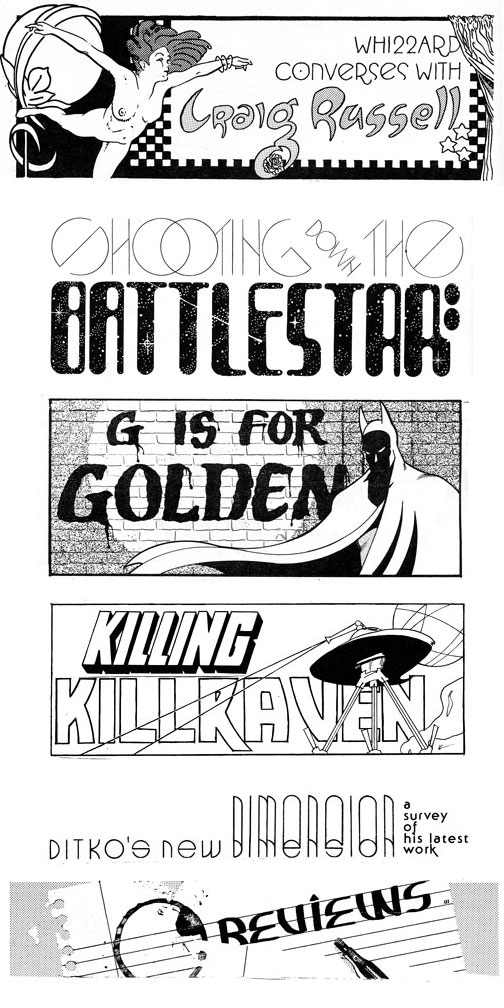
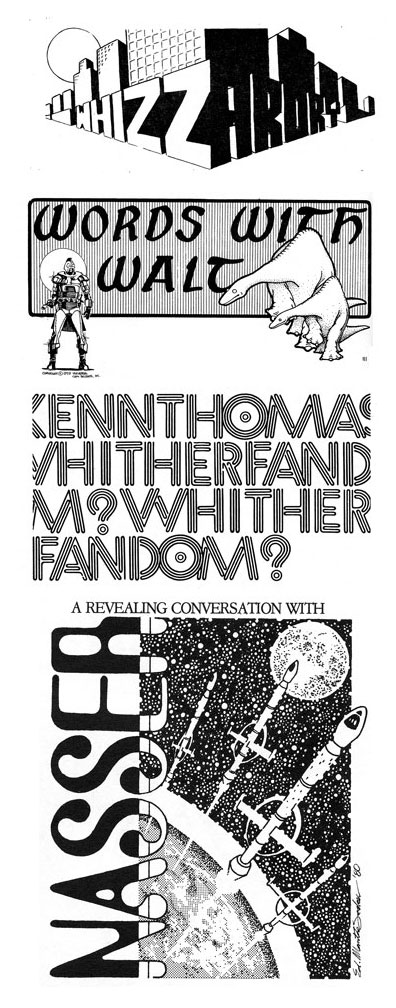 Above are so many examples of inventive uses of type, art, and the combination of the two. Art heavy logos like the Craig Russell interview head at top emulate the interview subject’s own style, while the Whither Fandom text only logo second from bottom is clever in the disappearing type, echoing the subject matter of the column. And editor Klug did not shirk the crediting for these either. Each issue had a separate column in the contributors area for “letterers.”
Above are so many examples of inventive uses of type, art, and the combination of the two. Art heavy logos like the Craig Russell interview head at top emulate the interview subject’s own style, while the Whither Fandom text only logo second from bottom is clever in the disappearing type, echoing the subject matter of the column. And editor Klug did not shirk the crediting for these either. Each issue had a separate column in the contributors area for “letterers.”
For the most part, Whizzard focused on the popular youngbloods of the industry, as you would expect. It wasn’t a historical tome like Alter Ego, for example. Issue 12 has interviews with Walt Simonson, Jim Starlin, Mike Golden, and Michael Nasser. Marty Klug also often complemented most interviews with accompanying articles, as well as indexes of the interview subjects’ work. You got the complete package with Whizzard! Klug was not a glad handing, ego stroking sycophant, either. He was not afraid to delve into prickly topics, such as Marvel’s treatment of its freelancers in the Starlin interview, for example. And of course, the interviews and articles were made more visually appealing with full page illustrations and spot illustrations. First, below are a few spots from issue 12.
 Above, aside from the whimsical Terry Austin/Al Milgrom Hulk illo, you can see the clean and smooth work of Alan Hunter, a Brit who was a sort of staff artist for Klug. Below are a few Starlin related full pagers, the first by Starlin himself, followed by a piece by Ed Mantels.
Above, aside from the whimsical Terry Austin/Al Milgrom Hulk illo, you can see the clean and smooth work of Alan Hunter, a Brit who was a sort of staff artist for Klug. Below are a few Starlin related full pagers, the first by Starlin himself, followed by a piece by Ed Mantels.
Other articles include Comics: The State of the Medium by Jerry Durrwachter, a Silver Surfer piece by Kenn Thomas, Tarnish on the Silver Age by Michael McFadden, the Manhunter companion article, along with reviews, an editorial (Small Talk), a letters page (with a letter from a senior high school wannabe artist, Ken Meyer Jr), and a funny Marvel Bullpen parody about the Whizzard gang. There is also a sequential story that appears in each issue by Bill Nichols, Rick Burchett, and others featuring a lighthearted character called The Atomic Kid. See a spread below.
Rick did a ton of fanzine work, and later went on to work for a wide range of companies, including First, Pacific, Capital, and later both DC and Marvel. He is also a two time Eisner award winner.
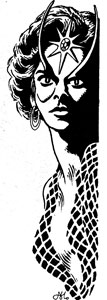 The parade of great interview subjects continues with issue 13. Within this issue, you will find interviews with Marshall Rogers, Craig Russell, Tim Conrad, Steve Gerber, and Don McGregor. As for new art, well, there isn’t much. From what I can tell, all the work from the artist interviews are reprinted, with the cover being by Rick Burchett. There are a few nice spots, especially, once again, Alan Hunter, which you see at left. Again, to complement the interviews, we have an article on Marshall Rogers’ Batman by Rich Morrissey, Killing Killraven by editor Klug, and indexes for Tim Conrad, Marshall Rogers, and Craig Russell. Also for your reading pleasure, you will find a survey of Steve Ditko’s current work, an article on the short history of graphic novels (up to that point), a review section, an article on saturday morning cartoons, the editorial (Small Talk), and the letters page. You will also be treated to another episode of The Atomic Kid by Bill Lewis and crew.
The parade of great interview subjects continues with issue 13. Within this issue, you will find interviews with Marshall Rogers, Craig Russell, Tim Conrad, Steve Gerber, and Don McGregor. As for new art, well, there isn’t much. From what I can tell, all the work from the artist interviews are reprinted, with the cover being by Rick Burchett. There are a few nice spots, especially, once again, Alan Hunter, which you see at left. Again, to complement the interviews, we have an article on Marshall Rogers’ Batman by Rich Morrissey, Killing Killraven by editor Klug, and indexes for Tim Conrad, Marshall Rogers, and Craig Russell. Also for your reading pleasure, you will find a survey of Steve Ditko’s current work, an article on the short history of graphic novels (up to that point), a review section, an article on saturday morning cartoons, the editorial (Small Talk), and the letters page. You will also be treated to another episode of The Atomic Kid by Bill Lewis and crew.
I have to confess, it is even more interesting to read these interviews right now, as I am in the middle of the great new Marvel history book by Sean Howe called Marvel Comics, the Untold Story. Coincidentally, I am in the midst of reading about the 80s version of ye ol’ Marvel, when young guns like McGregor and Gerber stormed into Marvel and stormed right out again. You will read about some of the reasons for these comings and goings in the interviews in these issues of Whizzard. Below are a few Tim Conrad pieces from issue 13. These illustrations may have appeared in Epic. The bottom piece looks as if it had been planned to utilize a “color hold” for clouds those lightning bolts would be issuing from.
Issue 14 starts off with a full color bold head shot of Martian Manhunter by Michael Nasser and Terry Austin (Austin would ink several illustrations for Klug during the fanzine’s history). The interview subjects this issue are Paul Gulacy, Dick Giordano, and Michael Nasser (now Michael Netzer). Nasser especially turns out to be a subject with deeply held views on society, religion, and other real world subjects, which are given as much space as the usual “how did you get into comics” type of questions. Below are a few illustrations from the main subjects.
The accompanying articles include an article on McGregor and Gulacy’s Sabre by Marty Klug, a Battlestar Galactica article (the comic, not the television show), a somewhat scathing article on fandom by Kenn Thomas, a short article on the rarest comics (Unsung Heroes), another Atomic Kid installment, and more. There is even a small illo by yours truly. One very beautiful illustration sits on the inside back cover by Ed Mantels (who, for some reason by this point wanted to be known as Ed.Mantels-Seeker), seen below.
To sum up, if interviews are your bag, then Whizzard is one wonderfully illustrated, text-stuffed bag! Unfortunately, I have heard from Marty Klug that he would not like the whole issues available as downloads, so the column will have to suffice! Lastly, I apologize for missing a few months, life just interfered. That included a move from one coast to the other, as well as painting 500 sketch covers of zombies for Avatar publishing. Go to my Facebook page and look for the folder named zombies to see a few.
Ken Meyer Jr.
kenmeyerjr@yahoo.com



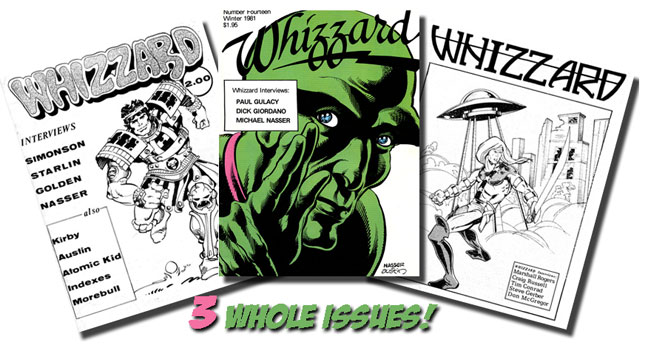
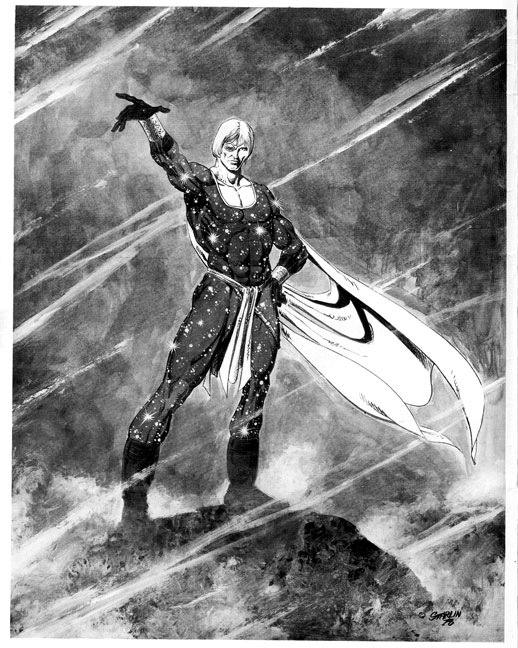
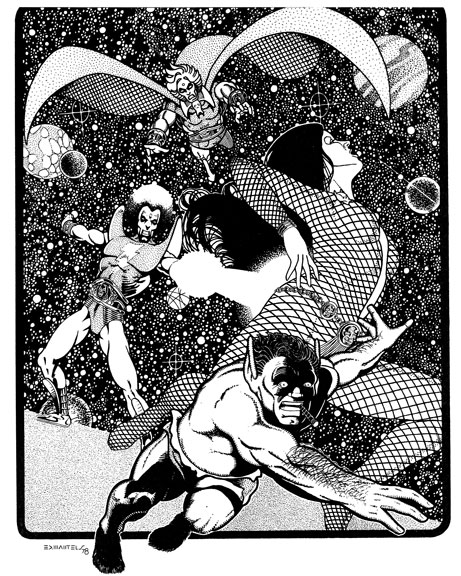
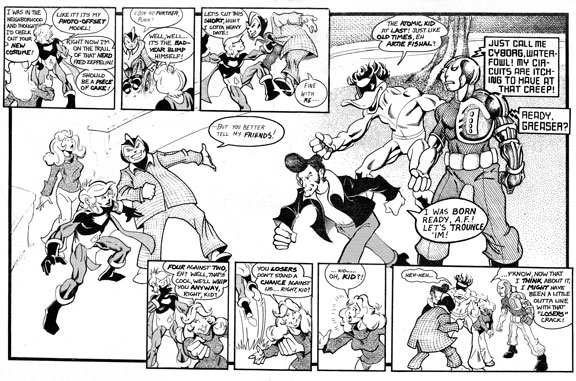

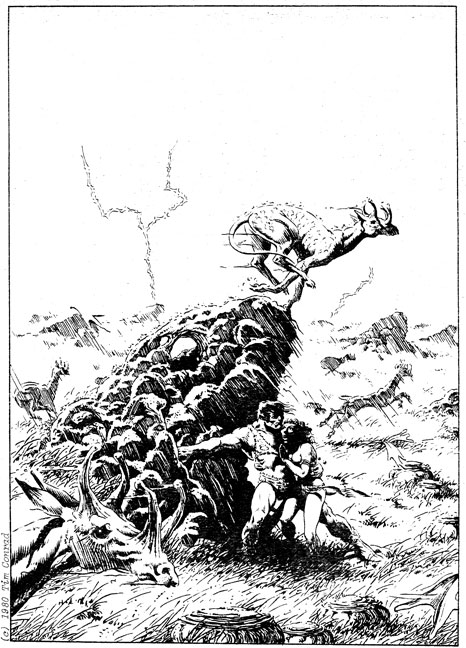

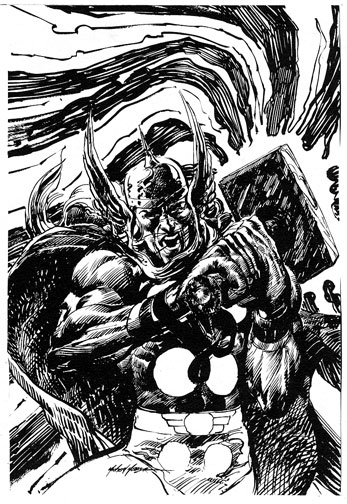
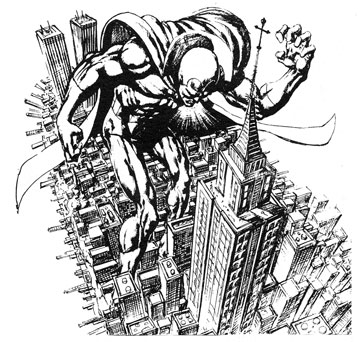
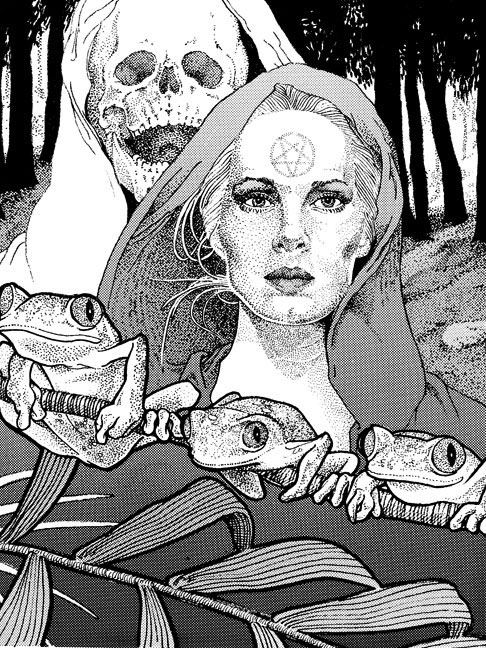
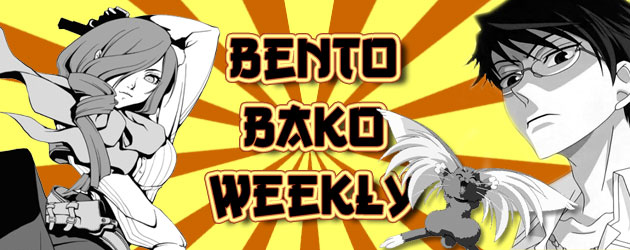
Thanks for posting these—I’ve been looking for that Starlin interview for a while!—and for the nice words about the book.
Heyyyy, Sean! Just finished it and it was freaking awesome! You did such an amazing job of weaving all that information together in an engaging and informative narrative. And thanks very much for reading and commenting. If you need anything else, just let me know!
Hey! I’m a week late in checking this out but since it’s stuff I’ve never seen before, that’s OK! Always love your posts here, Ken. This one, as usual, is both informative and fun. Thanks!
I missed out completely on the ‘zine “Whizzard.” The three copies you highlight all came out while I was in USAF technical school in Mississippi, or living in England, and I’d never seen copies during the intervening years.
It looks like a great ‘zine, and looks like it was a precursor to “David Anthony Kraft’s Comics Interview” magazine, which debuted in 1983.
I love the artistic column headers. They are really beautifully designed.
Great to finally see these issues! The comics-zine with two “z”s.
Richard and Russ, thanks very much for reading and commenting. Russ, I do try to play with the headers when I can and have time…some turn out better than others! I am thinking of doing the final issue of The Collector next time, as I finally heard back from Bill Wilson, so he can finally pipe in! And Russ…you did some zines yourself, right? I know you contributed to a ton, but I don’t think I have any you actually did yourself…clue me in (or just remind me, my memory sucks).
Oh, Jason, just saw you…thanks for commenting!
Back in 1974, when I published my first issue of “Maelstrom,” I sent free copies to ‘zine editors I admired — one of which was Bill G. Wilson. Bill wrote back and complemented my first issue, saying something to the effect that it was better than his first six issues, or somesuch. What really impressed him, though, was the fact that my cover was drawn by Michael Wm Kaluta — someone who Wilson had previously tried to get to do a “Collector” cover, but who had declined. I explained to Bill that I was simply lucky, as my request showed up in his mailbox right after he’d been taken off of DC’s “The Shadow” comic book.
My first two issues of “Maelstrom” were published in 1974, and while they had some flashes of competence and exuded a tidal wave of youthful enthusiasm, they were pretty crappy overall. Issue #3 was published in 1987, and it was much better, and #4 (1988) was pretty good as well. Issue #5 (1989) and #6 (1990) were smaller, digest-sized efforts that had some good stuff in them. “Maelstrom” #7 (1999) was the 25th anniversary issue, and in addition to having a new Shadow/Rocketeer cover by Kaluta, was also the best issue up to that point. But I think issue #8, published in 2002, was the best issue of all. If I’m still lucky enough to be around in 2014, I hope to publish “Maelstrom” #9, the 40th anniversary issue (choke!)!!! I’ll ask Kaluta one more time if he wants to keep the tradition going. I’ll even probably nag Steve Ditko one more time, as I’ve been asking him to contribute to “Maelstrom” since the mid-1970s.
Heads up, readers. I heard from Marty Klug (couldn’t find him when I did the column), and he requested that the links to the whole issues be taken out. If there is some segment you want from any of the issues, let me know, and I will see what I can do.
I will have to track a few of those issues down, Russ…I remember the name, but I don’t think I ever saw the actual zine!
Hi, nice post. I am writing a short essay about Steve Gerber in Spanish and I would appreciate to have the chance to read the interview included in # 13, which I think it is focused on Stewart the Rat. Would you please post or send me the scans of these pages? Thanks!
Javier, just saw this…if it’s not too late, email me at kenmeyerjr@yahoo.com and I can get you what you need.
I have issues 11-14, and I think until THE COMICS JOURNAL got up and running, this was the best fan publication with interviews of comics writers and artists. And the illustrated interviews are fairly similar in style to JOURNAL interviews (I have a complete run of the Journal from about 28-140, and scattered issues after.)
Of the WHIZZARD issues, they include:
Issue 11 (Summer 1978) interviews of Howard Chaykin, Terry Austin,Barry Smith, and Jim Steranko
Issue 12 (1979) interviews of Simonson, Starlin, Golden, and Nasser
Issue 13 (1980) Interviews of Marshall Rogers, Craig Russell, Tim Conrad, Steve Gerber, and Don McGregor (MY FAVORITE ISSUE !)
Issue 14 (1981) Interviews with Paul Gulacy, Dick Giordano and Mike Nasser (which appears to be the last issue)
Plus other articles, book reviews, and letter columns. These also resemble those in the COMICS JOURNAL.
The issues previous to these I’ve never seen beyond the covers, but from the back issues offered, and listings I’ve seen online, are less comics oriented, and more focused on science fiction authors, and pulp magazines and artists, especially Doc Savage, and the Shadow.
The ones I’d like to buy to fill out my collection are absurdly high-priced, about 40 to 50 dollars each! I had 13 since it came out, and got a set of 11-14 as a set for about 10 bucks 7 or 8 years ago. I’d hate to pay top dollar for them now, and will look for them when they’re more sporadically offered at a more sane price.
I’m surprised editor Marty Klug didn’t want you to make these issues viewable online. They were hard to find BACK THEN, and are doubly hard to find now. I’d think he’d want in this later era where his work is less remembered and hard to find, that he’d welcome you making his work available to be appreciated online, for the select few of us who can appreciate it.
One other thing I loved in these interviews, is they were always followed with an extensive checklist of the artist’s work.
Although there are sites online dedicated to that purpose now. One I use a lot is http://www.comics.org
These checklists in WHIZZARD might be considered obsolete now, but I like them because they give you an at-a-glance view of only their early work up to that point in time (1978-1981). Which for a number of these artists is my favorite material from these guys.